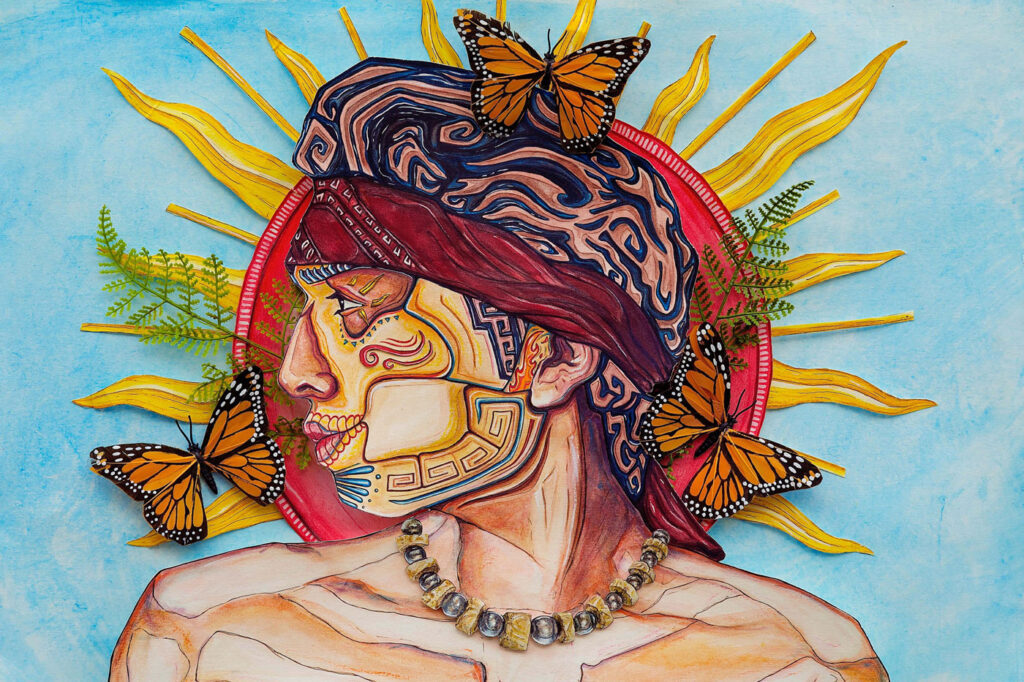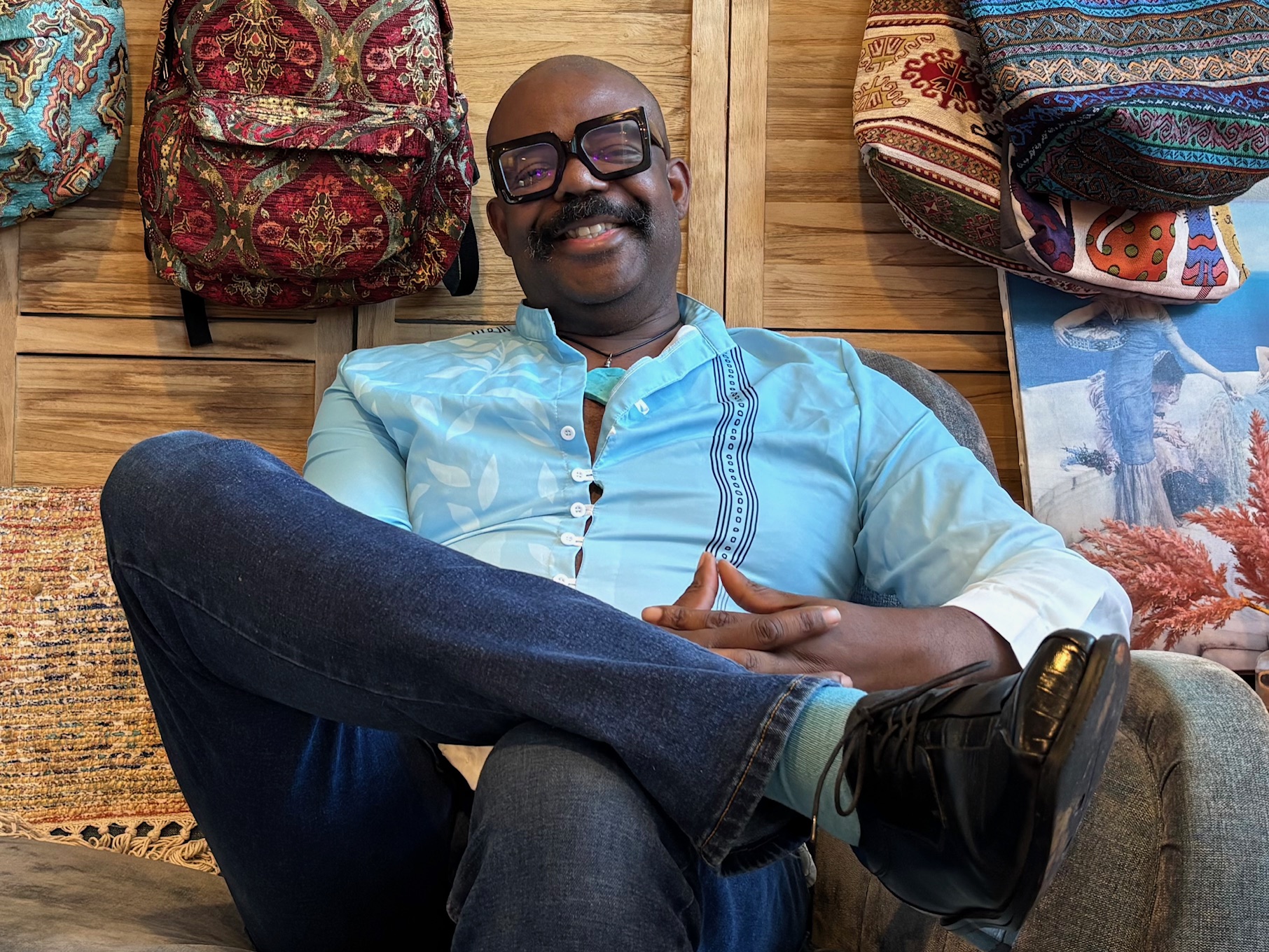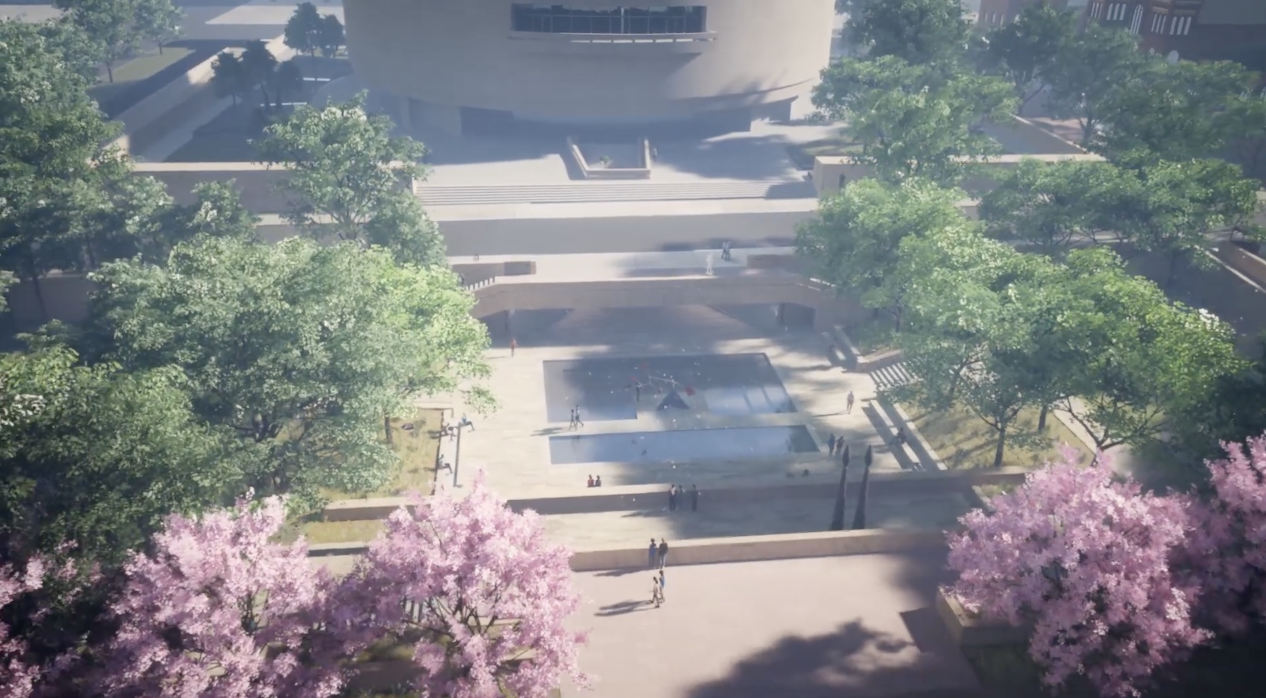(NEW YORK) – Mark Saldana, an up-and-coming artist to watch, steeps his art in the vitality of his heritage. His artworks are vehicles of growth and transformation not only for himself but also for viewers.
Mark Saldana’s bedroom looks as if you took the interior of Frida Kahlo’s home and gave it a 21st-century queer Brooklyn update. It’s plastered with art (mostly his own), traditional Mexican paper decorations, and framed posters of Rauw Alejandro’s GQ photoshoot. When asked about his outfit, Saldana gushes over Zoom. “It’s giving Bratz,” he giggles, revealing deep dimples.
The 26-year-old Queens-based artist sports a baggy, earth-toned sweater and vibrant striped pants — his favorite pajamas — paired with y2k translucent pink sunglasses from a 99-cent store, a brown corduroy fisherman’s hat, and loops of stringed pearls. He’s in what he calls his comfy era. But if this is comfy for him, imagine what going all out looks like.
Saldana infuses vibrancy and life into every inch of his art and persona, from his sartorial choices to how he talks. He beams with pride when discussing Kaleidospace, his Queens-based art collective that, he says, “focuses on the intersection of art, activism, and community.”
The group was recently featured on Spectrum Noticias NY1. It consists of six Latino multimedia artists, and they host regular free or low-cost art events that place people of color and LGBTQ+ artists at the forefront.
This summer, Saldana will take on another big public art installation: a large-scale mural in Jackson Heights. The mural, already in its planning stages, will grace a wall of the Garden School and will depict the diversity of indigenous plants and animals of Latin America. “The idea is ‘Queens Indigenous Garden,’” he says excitedly. “We want to implement Mesoamerican art and indigenous textile designs into the mural as well.”
Saldana and fellow visual artist and Kaleidospace member Kelly Arango are leading the project and collaborating with the school’s students. Jackson Heights is also known as the garden district—it was the nation’s first planned “garden apartment” community.
Saldana is a product of Corona, Queens, but he spent much of his childhood in Jackson Heights, a predominantly Latino neighborhood. Much of his art pays homage to the borough and its residents — spotlighting the immigrants, the street vendors, the essential workers, the working class, and the queer and Latin American communities at the intersections of his own identity.
“I always want to invest in my community and give back,” he says. A lot of his work concerns family bonds, chaos, and renewal. But even as he commissions treasured memories for others, he actively avoids depicting his own traumas. He’s also faced friction from murals associated with graffiti and gentrification in New York City and wants to reclaim that art form.
Saldana’s media of choice are watercolor and collage, and he often makes paintings and portraits commissioned by customers featuring family members and pets. He also creates custom pieces, flyers for organizations like New Immigrant Community Empowerment, and public murals.
Saldana’s most recent public art project, Somos Uno, was a series of 12 murals painted on the sides of planters in Travers Park, Queens. It incorporates themes of agriculture and immigrant life. He says the murals enliven the dull gray planters. “I wanted to incorporate the lives of the trees into the lives of the people and the community surrounding the park,” he explains. “I wanted people here to feel seen.” Part of this drive to give others representation stems from his own childhood desires — desires he feels often went unfulfilled growing up.
What is most important to Saldana as an artist is preserving family stories, representing queer and Latin American identity, and centering Queens in the narratives. “It empowers me to feel proud as a queer Mexican, seeing the queerness in my Queens community,” he says.
He takes great pride in his family portrait commissions. “I feel like, as an artist, I’m a middle man, mending past and present in a different way. I’m preserving moments and stories and keeping family lineages together. Some people weren’t privileged enough to have professional photos taken for their families or to see themselves rendered in art.”
But when it comes to his own family, he’s reserved. He rarely paints portraits of family members, and on past occasions when he did, he destroyed the art. Behind his bubbly demeanor are the struggles that many silently face: a history of struggling beneath his father’s abuse and alcoholism that’s impacted him since childhood.
“I have a different connection with them,” he says with a heaviness. “I don’t want to paint them because I don’t want to capture them or myself in the true reality of our sadness.” He doesn’t feel capable of painting them yet because he is afraid of triggering his mental health issues. He once painted still lifes of some of the messes left by his dad after drinking — broken bottles and trash scattered about — but he threw them out to dispose of their negative energy.
“I don’t want to spiral into the sadness, violence, and abuse that we endured in our lives.”
As a child, Saldana was extroverted, happy, and creative. Initially, his father fostered his sense of creativity – he would take him to the art supply store in Jackson Heights, buy him colored pencils and tracing paper, and show him how to draw, starting with tracing cartoons. “I would always trace everything, even the Bible at church,” Saldana laughs.
Things would start to change as his father’s drinking worsened. It would soon become an everyday occurrence, and no one in the house could escape the physical, verbal, and emotional abuse that ensued. His father was the main abuser, but his mom would double down – blaming Saldana for the abuse she received from her husband. Saldana would begin to habitually spend as much time outside the house as possible, waking up an hour early to sit on the steps of his school and cry.
However, Saldana had a strong support system with his friends at school. Most knew about his situation at home, no matter how hard he tried to cover it — his bruises would tell the real story. Teachers called child services on his family multiple times. “I remember crying and being so mad at my teacher when she called ACS, I didn’t talk to her. I was so afraid my dad would beat me because of that.”
Saldana found solace in his friends and their families, who’d provide him a space of refuge. “The families would take me in as their own. I was always searching for families with good relationships, and I’d end up becoming part of them,” he says. Because his own family was a deep source of trauma, he would seek out families that had good relationships with each other. “I always felt safer with them,” he says, admitting that his mom resented him for avoiding his own family. Stable familial bonds attracted him, which he continues to venerate in his own art.
Street vending became another outlet for Saldana to escape the abuse and darkness of his household. He would tag along with a friend’s family to help them sell fruits and vegetables on Roosevelt Avenue instead of spending time at home. In middle school, he found comfort and empowerment in street vending. It helped him get in touch with the community, start conversations, connect with strangers, and become the talkative extrovert he is now. It also taught him entrepreneurship and budgeting. That family that introduced him to street vending also became the first family he ever came out to — with them, he really felt like he could be himself.
Nowadays, his relationship with his parents is better, albeit strained. He has yet to come out to his father, and his mom chooses not to acknowledge that aspect of him. She still tells him to “tone it down” often. His parents also don’t celebrate his work or art — they only focus on the financial aspect of it. “It’s never like, wow, that’s such a cool opportunity. It’s like, how much are you getting paid, and how much are you giving us? It kills my mood,” he says.
They don’t discourage him, though. Art was always Saldana’s safe space — it was always there for him. “I just always knew it was what I was gonna end up doing. There was never another route for me,” he says. Even though his parents may not be as proud as he is, he sees them admire his work every now and then with a small smile. It’s enough.
While reflecting over Zoom, Saldana clutches his peluche, a stuffed dinosaur Rex from the movie Toy Story. “I’m healing my inner child,” he declares. “I want to make sure I’m doing something every day that my inner child would want to do, that would nourish him.”
These days, Saldana works as a mentor for young artists, teaching elementary school students at an after school program, including those who recently immigrated from Latin America. He’s also busy commissioning paintings and working on community-focused art events across Queens while tackling the mural project for the Garden School.
Saldana and Arango are excited to have such a large project commissioned and the artistic freedom that came with it, but New York’s rapid gentrification makes painting murals tricky. A fine line exists between what’s considered a mural (art) and graffiti (vandalism).
“We are seeing the erasure of murals and street art in New York due to new buildings coming up and the association of murals and graffiti with street culture and violence,” he says. “The city wants to move away from that for the comfort of gentrifiers, so taking up a big wall like this is really meaningful for us, especially on a private school building.”
Saldana argues that murals are very culturally important to New York City and that being commissioned to create such a large-scale one is part of his art activism. Artist Kacia Flórez, a collective member, says the mural is a major step towards artistic representation for them. “It really gives a sense of pertenencia, of belonging to the people in the community,” says Flórez. She admires the sense of vitality and vibrance Saldana infuses into his art and is sure this project will be a beautiful touch in the neighborhood.
Saldana and Arango met in middle school. Feeling like outsiders and longing to blend in with the white kids around them, they connected by creating art together. Through art, they gradually began to accept themselves as they were.
They want to ensure the project is collaborative, especially with the school kids. They plan to lead workshops for the students, asking what animals and plants the kids want to see reflected on the mural. “The whole project is meant to bring everyone in the community together and connect them to this imagined garden. It’s gonna be spiritual and therapeutic work for me,” Saldana says. “It’s gonna allow us to explore ourselves, our backgrounds, and connect with each other.”
Saldana was initially unsure about this project but decided to seize the opportunity. “I’m at a place feeling more secure and confident as an artist and not holding myself back anymore — I’m feeling excited and energized to tackle this big wall,” he says. Once a timid young artist suffering through domestic abuse, he is now as loud and exuberant as his art, celebrating community and uplifting outsiders while healing his inner child.
The main inspiration behind his art, Saldana says, is representing himself.
“Representing my Mexican American life, my upbringing, connecting with my community and representing them in my work is what I do as an artist. I grew up selling food on the street, and I see power in the street vendors of Roosevelt,” he says. “I always want to preserve immigrant stories, family stories, and queer stories. All of my art is connected and connected to me.”

Mixed media self-portrait,”La Mexicana,” by the artist Mark Saldana. [credit: Mark Saldana]

